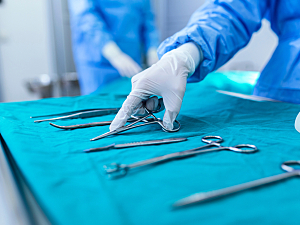Diaphragmatic elevation is usually due to eventration (absence of muscle fibers or tendon in a portion of the hemidiaphragm) or phrenic nerve palsy. Common causes of the latter are traumatic fracture of the first rib or clavicle, viral infection, nerve compression, or iatrogenic factors.
Patients who don’t improve with conservative therapy may undergo diaphragm plication—repositioning and/or reshaping of the diaphragm to expand lung capacity. Numerous approaches to this procedure have been reported (thoracotomy, thoracoscopy, laparoscopy, and robot-assisted surgery) with no consensus on the ideal technique.
Surgeons at Brigham and Women’s Hospital have developed a radial diaphragm plication technique that makes use of thoracoscopic instruments. Michael Jaklitsch, MD, program director of the Cardiothoracic Surgery Fellowship, Desiree A. Steimer, MD, associate surgeon, and other colleagues of the Division of Thoracic Surgery, describe the technique and its advantages in The Annals of Thoracic Surgery.
The Technique
The authors adapted the technique from one performed on pediatric patients via posterolateral thoracotomy. Their modifications are meant to reduce morbidity and postoperative pain.
The repair is intricate, involving numerous interrupted sutures. In summary, a series of pledgeted horizontal mattress 0-Ethibond sutures is used to create individual pleats in flaccid muscle, like the folds of a curtain:
- Sutures are placed 2 to 3 cm apart, circumferentially from posterior to anterior until the central tendon is taut
- A minimum of 10 to 15 sutures is recommended
- Each suture includes full-thickness bites of the diaphragm at two locations: one centrally in the flaccid portion and the other at the costophrenic gutter and ribs
- A noncompliant tendon is approximated to the chest wall
- Sutures are tied as they are placed to facilitate the placement of the next
The article describes the technique in detail with illustrations of key steps. Potential modifications include CO2 insufflation and the use of automated suture fastening devices.
Advantages and Indications
The technique is time-consuming but provides multiple points of fixation to the chest wall. Improving the distribution of tension along the flaccid muscle may achieve a more durable repair. In addition, sutures are not placed at the junction of the diaphragm muscle to the central tendon, which overlies the rami of the phrenic nerve and vessels. Avoiding the nerve fibers makes nerve recovery more likely.
The procedure is thus ideal for patients with phrenic nerve paresis or paralysis. Adults with eventration or multiple defects within the central tendon are not candidates.
Patient Cases
At the Brigham, patients have short hospitalizations (24–48 hours) and return to daily activities within a few weeks of plication. They report improvement in their symptoms within six weeks.
The authors briefly describe two patients who underwent thoracoscopic radial diaphragm plication after diaphragm elevation was detected on imaging. One, a 52-year-old man, was imaged because of severe dyspnea and left diaphragm paresis nine months after a viral infection. The other, a 77-year-old man, had persistent exertional dyspnea after immunotherapy and pulmonary rehabilitation for lung cancer.
Pre- and postoperative chest CT showed that patient 1 had an increase in lung volume of 150 cc one year postoperatively. In patient 2, the increases were 42 cc at three months and 289 cc at two years. These changes suggest radial plication provides long-term benefits.
